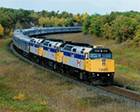There goes the whistle! The train back to Winnipeg will be leaving in 15 minutes. There's time for one more dance at the Grand Beach Ballroom, but don't be late - the last train to Winnipeg leaves at the stroke of midnight!
By 1920, as many as 40,000 vacationers a day rode the Canadian Pacific Railroad to Winnipeg Beach, 76 kilometres north of Winnipeg. On the eastern side of the Lake, thousands more boarded the Canadian National Railway's line to Grand Beach. There were as many as 15 trains a day up and down each shoreline, and even more reasons to take them: sun, sand, surf, boardwalks, roller coasters, and some of the finest dance halls in western Canada.
Both of Lake Winnipeg's most popular Lake Winnipeg resort communities owed their existence to the railroads. Winnipeg Beach was developed in 1901, after Sir Willliam Whyte of the Canadian Pacific Railway toured the Lake's western shore. He authorized the purchase of 134 hectares of land at the site of Winnipeg Beach, and began construction of a station and a dance pavilion. In 1903, the CPR's first beach line passengers disembarked at the new holiday destination.
In 1914, the rival Canadian National company began running trains to Grand Beach, on the opposite side of the Lake. The CNR built its own lakeside resort, and the day-tripping crowds poured in. The "Moonlight Special" was a popular train, delivering party-goers to the town's elegant dance pavilion early in the evening, and returning them to the city late at night.
The Lake Winnipeg beach trains also sparked a wave of cottage and campground development on both sides of the Lake. Convenient early-morning "daddy trains" from Winnipeg Beach took summer residents south to work in Winnipeg, and delivered them back to their cottages in time for dinner. During the 1920's in Grand Beach, a thriving cottage community took shape on former campground land owned by the CNR.
By the middle of the century, the advance of the automobile had rendered the beach trains obsolete. The dance hall at Winnipeg Beach became a roller rink, and the ballroom of Grand Beach was lost to fire. In Winnipeg Beach, a 40 metre-high steel water tower, built in 1928 to provide pressurized water for the CPR locomotives, has been preserved as an historical landmark and a lasting reminder of the Lake Winnipeg's railway heritage.
Author: Fredrick Buetefuer

